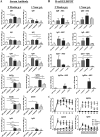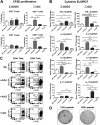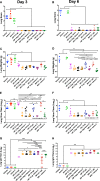Severe acute respiratory syndrome-associated coronavirus vaccines formulated with delta inulin adjuvants provide enhanced protection while ameliorating lung eosinophilic immunopathology
- PMID: 25520500
- PMCID: PMC4337527
- DOI: 10.1128/JVI.02980-14
Severe acute respiratory syndrome-associated coronavirus vaccines formulated with delta inulin adjuvants provide enhanced protection while ameliorating lung eosinophilic immunopathology
Abstract
Although the severe acute respiratory syndrome-associated coronavirus (SARS-CoV) epidemic was controlled by nonvaccine measures, coronaviruses remain a major threat to human health. The design of optimal coronavirus vaccines therefore remains a priority. Such vaccines present major challenges: coronavirus immunity often wanes rapidly, individuals needing to be protected include the elderly, and vaccines may exacerbate rather than prevent coronavirus lung immunopathology. To address these issues, we compared in a murine model a range of recombinant spike protein or inactivated whole-virus vaccine candidates alone or adjuvanted with either alum, CpG, or Advax, a new delta inulin-based polysaccharide adjuvant. While all vaccines protected against lethal infection, addition of adjuvant significantly increased serum neutralizing-antibody titers and reduced lung virus titers on day 3 postchallenge. Whereas unadjuvanted or alum-formulated vaccines were associated with significantly increased lung eosinophilic immunopathology on day 6 postchallenge, this was not seen in mice immunized with vaccines formulated with delta inulin adjuvant. Protection against eosinophilic immunopathology by vaccines containing delta inulin adjuvants correlated better with enhanced T-cell gamma interferon (IFN-γ) recall responses rather than reduced interleukin-4 (IL-4) responses, suggesting that immunopathology predominantly reflects an inadequate vaccine-induced Th1 response. This study highlights the critical importance for development of effective and safe coronavirus vaccines of selection of adjuvants based on the ability to induce durable IFN-γ responses.
Importance: Coronaviruses such as SARS-CoV and Middle East respiratory syndrome-associated coronavirus (MERS-CoV) cause high case fatality rates and remain major human public health threats, creating a need for effective vaccines. While coronavirus antigens that induce protective neutralizing antibodies have been identified, coronavirus vaccines present a unique problem in that immunized individuals when infected by virus can develop lung eosinophilic pathology, a problem that is further exacerbated by the formulation of SARS-CoV vaccines with alum adjuvants. This study shows that formulation of SARS-CoV spike protein or inactivated whole-virus vaccines with novel delta inulin-based polysaccharide adjuvants enhances neutralizing-antibody titers and protection against clinical disease but at the same time also protects against development of lung eosinophilic immunopathology. It also shows that immunity achieved with delta inulin adjuvants is long-lived, thereby overcoming the natural tendency for rapidly waning coronavirus immunity. Thus, delta inulin adjuvants may offer a unique ability to develop safer and more effective coronavirus vaccines.
Copyright © 2015, American Society for Microbiology. All Rights Reserved.
Figures






References
-
- Drosten C, Gunther S, Preiser W, van der Werf S, Brodt HR, Becker S, Rabenau H, Panning M, Kolesnikova L, Fouchier RA, Berger A, Burguiere AM, Cinatl J, Eickmann M, Escriou N, Grywna K, Kramme S, Manuguerra JC, Muller S, Rickerts V, Sturmer M, Vieth S, Klenk HD, Osterhaus AD, Schmitz H, Doerr HW. 2003. Identification of a novel coronavirus in patients with severe acute respiratory syndrome. N Engl J Med 348:1967–1976. doi:10.1056/NEJMoa030747. - DOI - PubMed
-
- Rota PA, Oberste MS, Monroe SS, Nix WA, Campagnoli R, Icenogle JP, Penaranda S, Bankamp B, Maher K, Chen MH, Tong S, Tamin A, Lowe L, Frace M, DeRisi JL, Chen Q, Wang D, Erdman DD, Peret TC, Burns C, Ksiazek TG, Rollin PE, Sanchez A, Liffick S, Holloway B, Limor J, McCaustland K, Olsen-Rasmussen M, Fouchier R, Gunther S, Osterhaus AD, Drosten C, Pallansch MA, Anderson LJ, Bellini WJ. 2003. Characterization of a novel coronavirus associated with severe acute respiratory syndrome. Science 300:1394–1399. doi:10.1126/science.1085952. - DOI - PubMed
Publication types
MeSH terms
Substances
Grants and funding
LinkOut - more resources
Full Text Sources
Other Literature Sources
Miscellaneous

